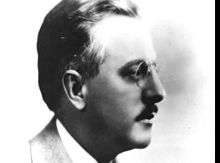Scott Bradley (composer)
Walter Scott Bradley (November 26, 1891 – April 27, 1977) was an American composer, pianist, arranger, and conductor.
Scott Bradley | |
|---|---|
 | |
| Background information | |
| Birth name | Walter Scott Bradley |
| Born | November 26, 1891 Russellville, Arkansas, U.S. |
| Died | April 27, 1977 (aged 85) Chatsworth, California, U.S. |
| Genres | |
| Occupation(s) | |
| Instruments | Piano |
| Years active | 1901–1977 |
| Labels | Metro-Goldwyn-Mayer |
Bradley is best remembered for scoring the Metro-Goldwyn-Mayer (MGM) theatrical cartoons,[1] including those starring Tom and Jerry (MGM Cartoon Studio, 113 of 114 shorts), Droopy (all 24 shorts), Barney Bear (all 26 shorts), Screwy Squirrel (all 5 shorts), George and Junior (all 4 shorts) and many one-off cartoons.
Career
In an autobiographical sketch,[2] Bradley noted that he began his career performing with and later conducting theatre orchestras in Houston, Texas. He studied organ and harmony with Horton Corbett, the choir director of Houston's Christ Church Cathedral, but was "otherwise entirely self-taught in composition and orchestration." (Years later, when he was already established in Hollywood, he sought to improve his technique by studying privately with MGM colleague Mario Castelnuovo-Tedesco).[3] In 1926, Bradley moved to Los Angeles to conduct programs over KHJ Radio, an activity that led to his growing involvement in animation at the start of the talkie era. He was a staff musician for Walt Disney (1929) and the Ub Iwerks studio (1930–1934), then became music director for Hugh Harman and Rudy Ising, who were hired to produce cartoon shorts for MGM. After MGM established its own cartoon studio in 1937, Bradley was hired permanently and remained with the company for twenty years.
During the 1930s, Bradley also composed music for the concert hall, including the tone poems "The Valley of the White Poppies" (1931) and "The Headless Horseman" (1932) and the oratorio "Thanatopsis" (1934), based on the poem by William Cullen Bryant. His most notable success was "Cartoonia" (1938), a four-movement orchestral suite of his MGM work, premiered by Pierre Monteux with the San Francisco Symphony. It was an early expression of Bradley's belief that cartoon music was an art form of great potential.[4]
As was common practice in scores for animation, Bradley's early style incorporated fragments of popular and traditional melodies. By the mid-1940s, however, his compositions and orchestrations had become more original and complex, occasionally utilizing the twelve-tone technique devised by Arnold Schoenberg; the first being the 1944 Tom and Jerry cartoon Puttin' on the Dog. Other influences were Béla Bartók, Igor Stravinsky and Paul Hindemith. Sight & Sound magazine quoted concertmaster Lou Raderman's mock complaint: "Scott writes the most blank-blank-blank difficult fiddle music in Hollywood … He is going to break my fingers!" [5]
Bradley expressed considerable pride in his "funny music" and believed scoring for animation offered far more possibilities to the composer than live-action films. About his score for MGM's Puttin’ on the Dog, he later wrote:
"I hope Dr. Schoenberg will forgive me for using his system to produce funny music, but even the boys in the orchestra laughed when we were recording it."[6]
The conductor Simon Rattle has specifically highlighted the influence of the Klaus-Narr passages in Schoenberg's Gurrelieder on Bradley's compositions.[7]
In 1954, MGM terminated his weekly contract but retained his services as a freelance, paying him $1,000 per film. This arrangement lasted until MGM closed its cartoon department in 1957, after which Bradley retired. He died on April 27, 1977 in Chatsworth, California and is buried at Chatsworth's Oakwood Memorial Park Cemetery.
By the late 1980s, Bradley's reputation had been overshadowed by that of his Warner Bros. counterpart Carl W. Stalling, but experienced a resurgence at the start of the 21st century. The first Bradley soundtrack album, Tom and Jerry and Tex Avery Too!, received a limited-edition release in 2006 and the "Cartoonia" suite was revived in a performance by the Cleveland Youth Orchestra in 2012. The following year, "Tom and Jerry at MGM", a six-minute orchestral suite of Bradley cues reconstructed by Peter Morris and John Wilson, received its world premiere at a BBC Proms concert in London.
References
- Scott Bradley at Walter Lantz|Cartoon Brew
- Goldmark, Daniel (2005), "Tunes for 'Toons: Music and Hollywood Cartoons", University of California Press, p. 46.
- Goldmark, Daniel (2005), "Tunes for 'Toons: Music and Hollywood Cartoons", University of California Press, p. 49.
- Goldmark, Daniel (2005), "Tunes for 'Toons: Music and Hollywood Cartoons", University of California Press, p. 50
- Maltin, Leonard (1987), "Of Mice and Magic", Penguin Books.
- Bradley, Scott (November 1, 2002). "Music In Cartoons". In Goldmark, Daniel; Taylor, Yuval (eds.). The Cartoon Music Book. Chicago Review Press. pp. 115–120. ISBN 978-1556524738.
- Interview with Holger Erdmann for liner notes of Gurrelieder (2002), EMI 7 24355 73032 9
Bibliography
- Goldmark, Daniel (2006): "Cartoon Concerto". Liner notes for Tom and Jerry & Tex Avery Too! Volume 1: The 1950s. Film Score Monthly CD Vol. 9 No. 17.
- Goldmark, Daniel (2005): "Tunes for 'Toons: Music and Hollywood Cartoons." University of California Press.
- Goldmark, Daniel and Yuval Taylor (eds.) (2002): The Cartoon Music Book. A Capella Books.
- Maltin, Leonard (1987): Of Mice and Magic: A History of American Animated Cartoons. Penguin Books.
- McCarty, Clifford (2000): Film Composers in America: a Filmography, 1911–1970. Oxford University Press.
- Morris, Peter (2007): Playing Cat and Mouse in BBC Music Magazine, March 2007. p44-48. British Broadcasting Corporation.
- Morris, Peter (2016): Humour Between the Keys in Sounding Funny (2016). Equinox Publishing.